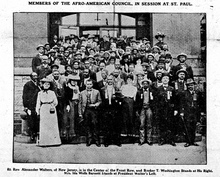National Afro-American Council

Afro-American Council at 1902 meeting in St. Paul, Minnesota. President Alexander Walters is front Center, with Ida B. Wells on his left, Booker T. Washington on his right. William H. Steward, T. Thomas Fortune, W. E. B. Du Bois, and Emmett Jay Scott are all in the second row.
|
|
| Formation | 1898 |
|---|---|
| Extinction | 1907 |
| Type | Non-profit organization |
| Purpose | African-American civil rights |
|
Presidents
|
Alexander Walters (1898–1902, 1905–07) Timothy Thomas Fortune (1902–04) William A. Pledger (1903acting) William Henry Steward (1904–05) |
The National Afro-American Council, the first nationwide civil rights organization in the United States, was created in 1898 in Rochester, New York. Before its dissolution a decade later, the Council provided both the first national arena for discussion of critical issues for African Americans and a training ground for some of the nation’s most famous civil rights leaders in the 1910s, 1920s, and beyond.
Led by A.M.E. Zion Bishop Alexander Walters, who was president for most of the Council’s existence, the Council attracted a wide range of African-American journalists, lawyers, educators, politicians, and community activists to its annual meetings. The Council was the brainchild of New York journalist Timothy Thomas Fortune, whose earlier attempt—the National Afro-American League—had failed to generate momentum, and disappeared in the early 1890s.
The Council was formed against a backdrop of violent lynchings and of increasing disfranchisement of African-American voters in the South. Alarmed by the lynchings and racial discrimination against African Americans, Bishop Walters circulated a national letter of appeal in the spring of 1898, just weeks after the brutal murder of African-American postmaster Frazier B. Baker in Lake City, South Carolina by an armed mob of whites. “It becomes absolutely necessary that we organize to protect ourselves,” Walters wrote, and more than 150 leaders from across the country signed the letter, which was published in Fortune’s New York Age. Some of them attended the organizational meeting in September 1898 in Rochester, following the dedication of a statue to the late abolitionist leader, Frederick Douglass.
The meeting endorsed creation of a non-partisan Council, to be supported by annual dues payments and based on the ideals expressed by the earlier League. Bishop Walters was elected as president, after Fortune declined to serve; other officers included journalist Ida B. Wells-Barnett of Chicago, secretary, and federal customs official John C. Dancy of North Carolina, first vice president.
...
Wikipedia
